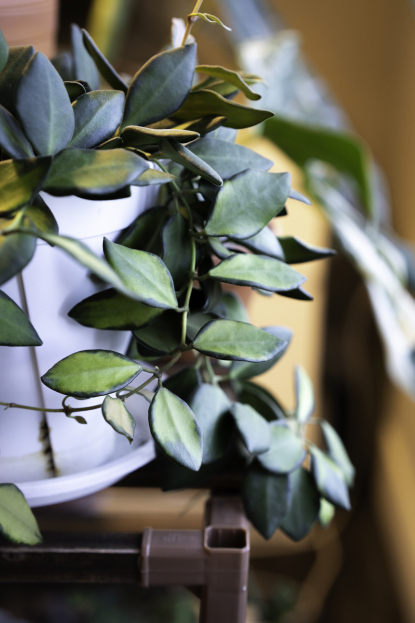
Hoya burtoniae is a delightful and compact species of wax plant, native to the Philippines. Loved for its fuzzy, almond-shaped leaves with maroon-tinged edges and clusters of small, fuzzy, pinkish-red flowers, this hoya is both a foliage and flowering star. Its cascading habit makes it perfect for hanging baskets, shelves, or trailing down from planters.
Like most hoyas, it’s relatively low maintenance and rewards patience with sweetly scented blooms—making it a joy to grow indoors.
Hoya burtoniae thrives in bright, indirect light. A spot near an east-facing window or a few feet back from a sunny south or west window is ideal. It appreciates plenty of light to bloom well, but avoid harsh direct sun, which can scorch its leaves.
Lower light will slow growth and reduce flowering, though it may still survive with decent foliage.
Let the soil dry out about halfway before watering again. Hoya burtoniae is semi-succulent and stores water in its thick leaves, so it's better to underwater than overwater. When you do water, do so thoroughly, allowing water to drain completely.
In winter, reduce watering frequency as the plant’s growth slows.
Hoya burtoniae enjoys moderate to high humidity—ideally 50–60% or higher—but it can adapt to average indoor conditions. If the air is very dry, consider:
Keep it in a warm spot between 65–85°F (18–29°C), and protect it from cold drafts or temps below 50°F (10°C).
Use a light, well-draining soil mix. A great blend might include:
This allows airflow to the roots while holding just enough moisture. Hoya roots like to be a bit snug, so no need to rush repotting—every 2–3 years is usually sufficient.
Feed your Hoya burtoniae every 4–6 weeks during spring and summer with a balanced liquid houseplant fertilizer (diluted to half strength). A bloom booster with higher phosphorus can help encourage flowering once mature.
No need to fertilize during the winter rest period.
When mature and given enough light, Hoya burtoniae produces clusters of star-shaped, fuzzy flowers in soft red or pink tones with a sweet, honey-like fragrance. Blooms often appear in spring or summer and grow from the same spot called a peduncle, so never cut these off—they’ll rebloom year after year!
Patience is key, as flowering may take a year or more.
Prune to shape or encourage branching by cutting just above a node. This can help your plant grow fuller and more compact. Remove any dead or yellowing leaves as needed.
You can also gently wipe the leaves occasionally to remove dust, helping the plant absorb light more effectively.
Hoya burtoniae propagates easily from stem cuttings:
Spring and early summer are the best times to propagate.
Hoya burtoniae is considered non-toxic to pets, though it’s always best to keep houseplants out of reach of curious mouths.